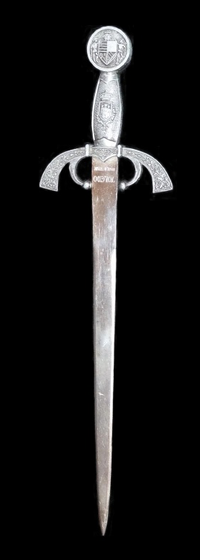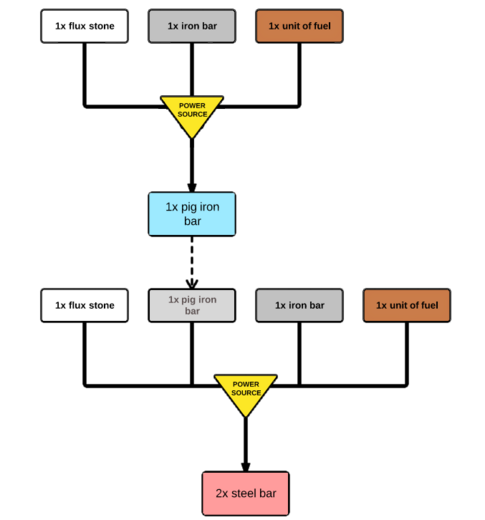- v50 information can now be added to pages in the main namespace. v0.47 information can still be found in the DF2014 namespace. See here for more details on the new versioning policy.
- Use this page to report any issues related to the migration.
Difference between revisions of "Steel"
(→Recipe) |
(→Recipe) |
||
| Line 75: | Line 75: | ||
Remember that smelting [[iron]] [[ore]] also requires 1 unit of fuel at a conventional smelter, producing 4 bars of [[iron]], which translates to half a unit of additional fuel used in the recipe above (although you will need a full unit up front.) | Remember that smelting [[iron]] [[ore]] also requires 1 unit of fuel at a conventional smelter, producing 4 bars of [[iron]], which translates to half a unit of additional fuel used in the recipe above (although you will need a full unit up front.) | ||
| − | To go from raw materials to finished products (assuming 1 bar per crafted item) a ratio of 8 iron bearing ore: 32 flux stone: 13 bituminous coal (or 26 lignite or | + | To go from raw materials to finished products (assuming 1 bar per crafted item) a ratio of 8 iron bearing ore: 32 flux stone: 13 bituminous coal (or 26 lignite or 104 logs) will have no leftover raw material and will yield 32 single-bar steel items. This is assuming, of course, that your dwarves can time travel and use the last remaining piece of coke to fire the first bituminous coal. |
Revision as of 04:29, 22 February 2017
| |||||||||||||||||||||||||||||||||||||||||||||||||||||||||
| Uses | |||||||||||||||||||||||||||||||||||||||||||||||||||||||||
|---|---|---|---|---|---|---|---|---|---|---|---|---|---|---|---|---|---|---|---|---|---|---|---|---|---|---|---|---|---|---|---|---|---|---|---|---|---|---|---|---|---|---|---|---|---|---|---|---|---|---|---|---|---|---|---|---|---|
| Graphic | |||||||||||||||||||||||||||||||||||||||||||||||||||||||||
|
No graphic. | |||||||||||||||||||||||||||||||||||||||||||||||||||||||||
| Recipe | |||||||||||||||||||||||||||||||||||||||||||||||||||||||||
| Properties | |||||||||||||||||||||||||||||||||||||||||||||||||||||||||
| |||||||||||||||||||||||||||||||||||||||||||||||||||||||||
v53.06 · v0.47.05 This article is about the current version of DF.Note that some content may still need to be updated. |
Steel is an alloy of iron and carbon (refined coal), made at a smelter. It is the best common metal for smithing most weapons and armor. Steel also has the third highest value of all metals, tied with that of gold.
Steel can be created at a smelter by a dwarf with the furnace operator labor activated.
Sedimentary Layers
To smelt steel, you will need iron bars, flux stone, and fuel. Flux is used to remove impurities, including carbon, during the smelting process, while fuel (charcoal or coke) removes oxygen and puts back in a small amount of carbon. The end result is steel: iron with just the right amount of carbon in it. The three ores of iron (hematite, magnetite, and limonite) can only be found in sedimentary layers, with the exception of hematite, which can occasionally be found in igneous extrusive layers. Furthermore, four of the five flux stones (calcite, chalk, dolomite, and limestone) are found only in sedimentary layers, as well as both coal ores (bituminous coal and lignite).
If you have no sedimentary layers at your fortress site, your only hope to make steel is with:
- hematite from igneous extrusive layers, or iron ore imported from trade caravans, or melting iron items brought by siegers (goblinite) and caravans
- marble from metamorphic layers, or imported flux
- charcoal from wood, or coke from imported bituminous coal or lignite
If you embark in a forest biome, you can produce thousands of units of wood from the surface trees alone, without even tapping into the caverns. Charcoal requires more labor per unit than coke, but is often easier to acquire.
Note that bituminous coal, like most stones, costs only 3☼ at embark or from caravans. With a cunning enough starting build, it is possible to embark with enough for several hundred units of coke. This is only possible if your parent civilization has access to coal; otherwise, it will not be available at all.
Recipe
Steel production is fairly complex compared to the creation of other alloys. Important note: in steelmaking, coke or charcoal is also used as an ingredient, apart from its use as fuel. A conventional (non-magma) smelter will require an additional unit of fuel in each reaction.
The first step is to create pig iron:
- Produces:
- 1 bar of pig iron
The second step combines the pig iron with plain iron to produce steel:
- 1 bar of iron
- 1 bar of pig iron
- 1 flux stone
- 1 unit of fuel (as a source of carbon)
- 1 unit of fuel, or magma (to heat the forge)
- Produces:
- 2 bars of steel
The overall reaction consumes 2 bars of iron, 2 units of flux, and 2 units of fuel as ingredients (plus an extra 2 fuel at a conventional smelter for heating). This produces 2 bars of steel.
Remember that smelting iron ore also requires 1 unit of fuel at a conventional smelter, producing 4 bars of iron, which translates to half a unit of additional fuel used in the recipe above (although you will need a full unit up front.)
To go from raw materials to finished products (assuming 1 bar per crafted item) a ratio of 8 iron bearing ore: 32 flux stone: 13 bituminous coal (or 26 lignite or 104 logs) will have no leftover raw material and will yield 32 single-bar steel items. This is assuming, of course, that your dwarves can time travel and use the last remaining piece of coke to fire the first bituminous coal.
"Steel" in other Languages
|
[INORGANIC:STEEL]
[USE_MATERIAL_TEMPLATE:METAL_TEMPLATE]
[STATE_NAME_ADJ:ALL_SOLID:steel]
[STATE_NAME_ADJ:LIQUID:molten steel]
[STATE_NAME_ADJ:GAS:boiling steel]
[DISPLAY_COLOR:0:7:1]
[BUILD_COLOR:0:7:1]
[MATERIAL_VALUE:30]
[SPEC_HEAT:500]
[MELTING_POINT:12718]
[BOILING_POINT:14968]
[ITEMS_WEAPON][ITEMS_WEAPON_RANGED][ITEMS_AMMO][ITEMS_DIGGER][ITEMS_ARMOR][ITEMS_ANVIL]
[SOLID_DENSITY:7850]
[LIQUID_DENSITY:6980]
[MOLAR_MASS:55845]
[IMPACT_YIELD:1505000]
[IMPACT_FRACTURE:2520000]
[IMPACT_STRAIN_AT_YIELD:940]
[COMPRESSIVE_YIELD:1505000]
[COMPRESSIVE_FRACTURE:2520000]
[COMPRESSIVE_STRAIN_AT_YIELD:940] 160
[TENSILE_YIELD:430000]
[TENSILE_FRACTURE:720000]
[TENSILE_STRAIN_AT_YIELD:225] 200
[TORSION_YIELD:430000]
[TORSION_FRACTURE:720000]
[TORSION_STRAIN_AT_YIELD:556]
[SHEAR_YIELD:430000]
[SHEAR_FRACTURE:720000]
[SHEAR_STRAIN_AT_YIELD:556] 77.4
[BENDING_YIELD:430000]
[BENDING_FRACTURE:720000]
[BENDING_STRAIN_AT_YIELD:215]
[MAX_EDGE:10000]
[ITEMS_HARD]
[ITEMS_METAL]
[ITEMS_BARRED]
[ITEMS_SCALED]
[STATE_COLOR:ALL_SOLID:BLUE-GRAY] |
| Base | |
|---|---|
| Alloys |
Billon • Bismuth bronze • Black bronze • Brass • Bronze • Electrum • Fine pewter • Lay pewter • Nickel silver • Pig iron • Rose gold • Steel • Sterling silver • Trifle pewter |
| Special | |

